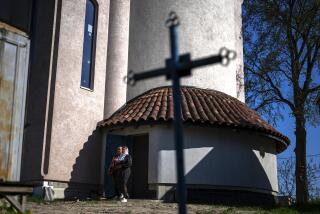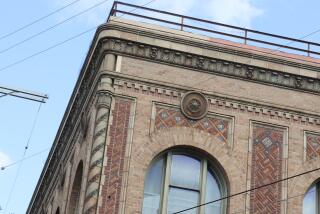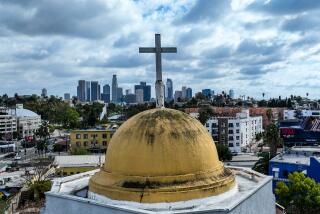Berkeley Congregation Plans to Re-Create 17th Century Temple
BERKELEY — A gem of Jewish architecture that was lost in the Holocaust could soon rise again--half a world away from where it originally stood.
The synagogue in Przedborz, Poland, was built in 1636 near the banks of the Pilica River. From the outside, it looked like a simple barn, but within the massive front doors was a spectacular sight: a 40-foot vaulted ceiling carved with biblical scenes, an elaborate pulpit and timbers adorned with jewels.
“It was the most beautiful place, so beautiful I don’t think I paid any attention to the prayers but to the walls and to the ceiling,” said Gina Nirenberg Kimelman, who was just 7 when she went there with her grandmother. “I came home and I would draw some of these things.”
This is the time that Kimelman prefers to remember: the last moments before the Nazis arrived in 1942, burned down the synagogue and killed off the town’s Jews.
Now Kimelman, 78, may soon have another chance to sit in that synagogue, thanks in part to her memories. Congregation Beth Israel in Berkeley plans to rebuild the synagogue to scale, realizing an ambition members first had 20 years ago as they discussed replacing their existing house of worship.
Wooden synagogues once dotted the landscape of Eastern Europe. Only about 10 are left, and none are in good repair; they are used as barns or sheds.
The Przedborz synagogue was a Polish treasure. Napoleon is said to have visited it. Tours stopped there in the 1920s and ‘30s. Photographs and architectural drawings of it were hidden during World War II, and later preserved in the archives in Warsaw.
Members of Berkeley’s Wooden Synagogue Committee unearthed the photos and drawings of the original building, which was remodeled in 1760. They noted that a large wooden Star of David dominated the outside wall facing the town’s center, an unusual feature that showed how accepted Jews were. Przedborz was 60% Jewish.
Kimelman, one of only four people in the United States known to remember details of the synagogue, told the committee about the rainbow of vibrant colors inside the building that the archive photos fail to capture.
“This is the first time a wooden synagogue is [being] rebuilt to house a living, breathing, growing, organic congregation, which is what makes it so special,” said Rabbi S. Yair Silverman of the Berkeley congregation.
Architects have used the drawings to replicate the original design and add features for modern use.
“The building burnt in a fire, and we’ve been hired to rebuild it,” said David Finn, an architect. “It happens to be 60 years later, and it happens to be in a different place.”
Artists from China, Italy, the Czech Republic and Jerusalem will complete wood carvings and other ornamental work that models the original structure.
The new structure will replace a modest Orthodox synagogue and will face the same direction as the Polish temple did.
Beth Israel’s congregants have contributed about $2 million for the project, and the synagogue committee has submitted grant requests to about 200 organizations seeking the additional $3.5 million required to build the temple.
Silverman hopes to break ground next fall and complete construction in a year. People of all religions and cultures will be encouraged to visit.
Barbara Budnitz, a member of the congregation, recently visited Przedborz. All that remains of the original synagogue is three stairs that lead down to the river and an old water pump, she said. “I almost feel like those people are with us and pushing us forward,” she said.
Kimelman remembers much about Przedborz, but never returned there because the memories were too painful. She grew up with her parents in Lodz, but had a large family in Przedborz, 40 miles south. Nazis rounded up her grandparents, aunts, uncles and cousins and forced them to dig their own graves. Others in the town were sent to the Treblinka death camp.
“Can you imagine? Somebody would come and have something against such a beautiful thing,” Kimelman said of the synagogue.
Kimelman was taken from the Lodz ghetto to Auschwitz in 1944. She was freed a year later when the war ended.
Seeing the synagogue again “will be like something coming back from the ashes,” Kimelman said. “Every time I will go there, I will see my family there. Me and my grandma just sitting there.”
More to Read
Sign up for Essential California
The most important California stories and recommendations in your inbox every morning.
You may occasionally receive promotional content from the Los Angeles Times.









